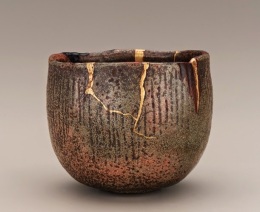My last official day of classes for my first year of seminary is Monday.
Thank God.
It’s been a rough year—an even rougher second semester—and I’m ready to switch into the next thing. (Of course, the next thing is itself an exhausting concept: I’m going to be basically a hospital chaplain over the summer, so I don’t know how much you’ll be hearing from me since I have to do 24-hour shifts every other weekend.) I will be heading home more scarred than I came here to The Wicket Gate, metaphorically and literally. I have grown older and in some ways sadder.
But I have also grown (hopefully) wiser. I have met some amazing people and had some crazy adventures. I have stepped into a new part of who I am. You know how this goes, Reader; you know how change always comes at a price—or, as a great blogger (BeautyBeyondBones) put it:

We are now in the season of Easter—yep, it’s not just one day. Easter is 50 days long in the liturgical calendar because, well, it kind of took a while to catch on. Jesus had to keep coming back and telling people yep, the rumors are true, I am no longer dead because let’s face it, Thomas wasn’t the only one who thought such a thing was unbelievable. We have all of these stories about Jesus appearing to various people and them being surprised each time; I’m actually preaching on the road to Emmaus next week (prayers for such are welcome) because the Resurrection didn’t just settle into being an accepted reality on that first Easter Sunday.
The thing about these appearances of Jesus, though, is that He didn’t come back perfect and shiny and new. He comes back with scars—“look at My hands,” He tells Thomas. “Put your finger in my side.” The Resurrection didn’t—and doesn’t—make the Crucifixion un-happen.
Which kind of blows my mind as a person of faith, actually. We as Christians have built ourselves around the Good News (and boy howdy is it good news) that Christ is risen, that Death is defeated, that hallelujah the tomb is empty. Every Sunday is a little Easter. But our God is not a God of completely erasing that which is broken and painful and ugly; our God is not a God of sweeping things under the rug. Jesus could well have come back in a body as smooth as the day He was born, hands no longer bearing the small cuts and splinter marks of life as a carpenter, eyes no longer crinkling with the first signs of age. He could have come back with a perfect body.
But instead He came back with the marks of having lived, and died. He came back with the white lines of scar tissue on His palms, with the thick and shining flesh across the holes in His wrists, with the gouged-out hole in His side. He came back with a body that bore witness on every inch of the brown skin of brokenness, of pain, of horrifying violence, of sorrow and abandonment and misery.
He came back with a body that looked an awful lot like our world feels, honestly.
The difference, however, is that His scars were scars, not open wounds. No blood poured into Thomas’ hands; no bones showed through the criss-crossed cuts on Jesus’ back. One of the many miraculous and hopeful things about the Resurrection is not that Jesus fought death to be restored to pre-Crucifixion health but that Jesus won over death to ensure the reality of healing. We who are Easter people follow a God Who knows exactly what it’s like to be broken into pieces and get put back together with the brokenness as part of who we are.
It’s not about it making us stronger—I’ll confess, I actually loathe the motto “that which doesn’t kill you makes you stronger” because I think it’s untrue and harmful. (There are some things that happen that don’t kill you but you wish they had; there are some things that don’t kill you but maim you; there are some things that don’t kill you but weaken you from the sheer amount of emotional or physical blood loss they cause.) Christ didn’t die so He could come back stronger, and I don’t think God is calling us to die to ourselves so we can be spiritually stronger like we’re in a weird Christian Gatorade ad. The Resurrection, I think, is about showing us that we can be healed from even the worst of things—made not stronger, but whole.
 There’s an illustration that I’m pretty sure every pastor has to use at least once in his/her career about this broken/whole thing, namely kintsugi or the Japanese art of repairing broken pottery with gold-brushed lacquer. It’s a beautiful metaphor, it really is, and it has everything to do with this resurrection that isn’t truly restoration. What was broken is not remade such that it looks like no harm was done. It is healed such that the harm is no longer the defining aspect, such that a broken Body can bring an entire world hope.
There’s an illustration that I’m pretty sure every pastor has to use at least once in his/her career about this broken/whole thing, namely kintsugi or the Japanese art of repairing broken pottery with gold-brushed lacquer. It’s a beautiful metaphor, it really is, and it has everything to do with this resurrection that isn’t truly restoration. What was broken is not remade such that it looks like no harm was done. It is healed such that the harm is no longer the defining aspect, such that a broken Body can bring an entire world hope.
Happy Easter, Reader, for every one of the fifty days, and every one of the revelations, and every one of the moments Jesus tells us again, yep, still true; I am alive. Peace; do not be afraid.
For I delivered to you first of all that which I also received: that Christ died for our sins according to the Scriptures, and that He was buried, and that He rose again the third day according to the Scriptures, and that He was seen by Cephas, then by the twelve. After that He was seen by over five hundred brethren at once, of whom the greater part remain to the present, but some have fallen asleep. After that He was seen by James, then by all the apostles. Then last of all He was seen by me also, as by one born out of due time. (1 Corinthians 15:3-8, NKJV)
I needed to hear your words and they impacted me powerfully. Thank you being a beautiful vessel.
LikeLike
You’re welcome. I’m glad they resonated with you.
LikeLike